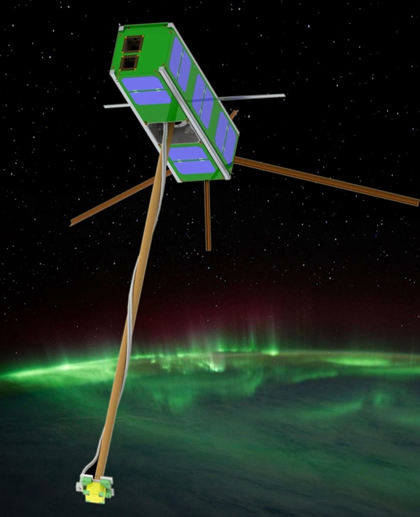UCLA Students Building Small Satellite
- By Dian Schaffhauser
- 08/11/14
In two to three years students at the University of California Los Angeles will be able to watch the launch of a satellite being built entirely on campus, thanks to grants from NASA and the National Science Foundation. The job of the satellite, which is no bigger than a loaf of bread with a cane attached to it, will be to conduct research on space weather.
The satellite being designed and built by the Electron Losses and Fields Investigation, nicknamed "ELFIN," will monitor solar wind particles and radiation within Earth's environment. Those components make up the solar and geomagnetic storms that disrupt communications and electricity networks and could in their severest forms cause catastrophic failure of power grids.
| |

The satellite being designed and built by the Electron Losses and Fields Investigation, nicknamed "ELFIN," will monitor solar wind particles and radiation within Earth's environment. |
|
"With the advent of space tourism and the increased reliance on satellites, understanding space weather is becoming increasingly important to our society," explained Vassilis Angelopoulos, ELFIN principal investigator and a professor in the department of Earth, Planetary and Space Sciences. "We need to study the electron loss process to assemble the full picture of how space radiation is driven by solar particles."
That department is collaborating on the project with the university's Mechanical and Aerospace Engineering and Atmospheric & Oceanic Sciences departments as well as Aerospace Corporation.
ELFIN has been in progress for several years, as a "labor of love" among students. Eventually, in 2013 the United States Air Force funded development with a $110,000 grant that was applied to the purchase of parts. Then, in February 2014 NASA offered the program a launch spot through its CubeSat Launch initiative. CubeSat lets schools send small satellite payloads on rockets planned for upcoming launches.
Then in May the project won a $1.2 million grant from NASA and the National Science Foundation, which will cover the expenses of making sure the equipment is "space qualified" and operating it for six months from a "Mission Operations Center," to be located on campus.
The entire project — including that center — will help train "tomorrow's leaders in space science and engineering," said Richard Wirz, mission co-investigator and an instructor in the department of Mechanical and Aerospace Engineering. "This educational experience enables students to apply what they learn in the classroom in a hands-on, team setting and do whatever it takes to reach a scientifically compelling and challenging goal."
The satellite is on the calendar to launch in late 2016 or early 2017. It will be disengaged from the launch vehicle to be set into a polar orbit about 370 miles from earth. From there it will monitor ultra-low frequency electromagnetic waves to help determine the physical mechanisms responsible for removing high-energy electrons from the Earth's radiation belts through precipitation into the upper atmosphere. That, in turn, will help scientists predict the impact of future space weather storms.
"This was impossible to do before, because no previous mission had the angle and energy resolution that ELFIN has," Angelopoulos said. "Our students will be able to contribute to space research in a very unique and meaningful way."
This month ELFIN's engineering design review will be held at the Small Satellite Conference at Utah State University.
About the Author
Dian Schaffhauser is a former senior contributing editor for 1105 Media's education publications THE Journal, Campus Technology and Spaces4Learning.